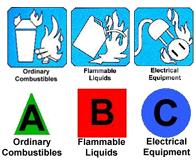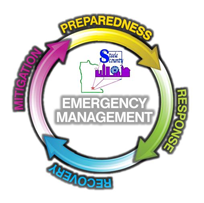Fire Extinguisher Ratings
 There are basically many different types of fire extinguishers and ratings. The rating of a fire extinguisher indicates the type of fire it is designed to extinguish. Ratings are Class A, Class B, Class C, or Class D. Some fire extinguishers have multiple ratings, such as Class A-B or Class A-B-C. Additionally, Class A and Class B fire extinguishers have a numerical rating which is based on tests conducted by Underwriter’s Laboratories that are designed to determine the extinguishing potential for each size and type of extinguisher.
There are basically many different types of fire extinguishers and ratings. The rating of a fire extinguisher indicates the type of fire it is designed to extinguish. Ratings are Class A, Class B, Class C, or Class D. Some fire extinguishers have multiple ratings, such as Class A-B or Class A-B-C. Additionally, Class A and Class B fire extinguishers have a numerical rating which is based on tests conducted by Underwriter’s Laboratories that are designed to determine the extinguishing potential for each size and type of extinguisher.
Older fire extinguishers are labeled with colored geometrical shapes with letter designations. Newer fire extinguishers use a picture/labeling system to designate which types of fires they are to be used on. Both of these types of labels are shown below with the description of the different classes of extinguishers.

Class A Extinguishers will put out fires in ordinary combustibles, such as wood and paper. The numerical rating for this class of fire extinguisher refers to the amount of water the fire extinguisher holds and the amount of fire it will extinguish.

Class B Extinguishers should be used on fires involving flammable liquids, such as grease, gasoline, oil, etc. The numerical rating for this class of fire extinguisher states the approximate number of square feet of a flammable liquid fire that a non-expert person can expect to extinguish.

Class C Extinguishers are suitable for use on electrically energized fires. This class of fire extinguishers does not have a numerical rating. The presence of the letter “C” indicates that the extinguishing agent is non-conductive.

Class D Extinguishers are designed for use on flammable metals and are often specific for the type of metal in question. There is no picture designator for Class D extinguishers. These extinguishers generally have no rating nor are they given a multi-purpose rating for use on other types of fires.

Class K fires involve combustible cooking media. A special wet chemical agent extinguishes and suppresses these very hot and reflashable fires.

Many extinguishers available today can be used on different types of fires and will be labeled with more than one designator, e.g. A-B, B-C, or A-B-C. This is the labeling that shows this extinguisher may be used on Ordinary Combustibles, Flammable Liquids, or Electrical Equipment fires. Make sure that if you have a multi-purpose extinguisher it is properly labeled.

This is the new labeling style with a diagonal red line drawn through the picture to indicate what type of fire this extinguisher is NOT suitable for. In this example, the fire extinguisher could be used on Ordinary Combustibles and Flammable Liquids fires, but not for Electrical Equipment fires.
Types Of Fire Extinguishers
The extinguishing agent inside the fire extinguisher determines the Class Rating:
- Dry Chemical extinguishers are usually rated for multiple purpose use. They contain an extinguishing agent and use a compressed, non-flammable gas as a propellant. These are the most common type of fire extinguisher in use today.
- Halon extinguishers contain a gas that interrupts the chemical reaction that takes place when fuels burn. These types of extinguishers are often used to protect valuable electrical equipment since them leave no residue to clean up. Halon extinguishers have a limited range, usually 4 to 6 feet. The initial application of Halon should be made at the base of the fire, even after the flames have been extinguished.
- Water extinguishers contain water and compressed gas and should only be used on Class A (ordinary combustibles) fires.
- Carbon Dioxide (CO2) extinguishers are most effective on Class B and C (liquids and electrical) fires. Since the gas disperses quickly, these extinguishers are only effective from 3 to 8 feet. The carbon dioxide is stored as a compressed liquid in the extinguisher; as it expands, it cools the surrounding air. The cooling will often cause ice to form around the “horn” where the gas is expelled from the extinguisher. Since the fire could re-ignite, continue to apply the agent even after the fire appears to be out.
How to Use a Fire Extinguisher
Fire extinguishers are easy to use. Even though extinguishers come in a number of shapes and sizes, they all operate in a similar manner. Here’s an easy acronym for fire extinguisher use:
P A S S — Pull, Aim, Squeeze, and Sweep
Pull the pin at the top of the extinguisher that keeps the handle from being accidentally pressed.
Aim the nozzle toward the base of the fire.
Squeeze the handle to discharge the extinguisher.
Sweep the nozzle back and forth at the base of the fire.
Stand approximately 8 feet away from the fire. If you release the handle, the discharge will stop. After the fire appears to be out, watch it carefully since it may re-ignite!
Where To Place A Fire Extinguishers
It is recommended to have at least one fire extinguisher on each floor of your home. Also, keep them in plain sight and no more than five feet above the floor. The most important places to have a fire extinguisher are in areas that are more susceptible to fire. These areas are the kitchen and the garage.
Do not put them in closets because that will cost you valuable time when you are reaching for it. And even though a fire extinguisher may not match your décor, do not put it behind curtains or drapes.Do not put the fire extinguisher near the stove as it will be out of your reach if the fire is on the stovetop. You should not have to risk burns just to reach your extinguisher. The best place to put the fire extinguisher is by the door of the kitchen so you have easy access to it.
Maintaining A Fire Extinguisher
The biggest maintenance need is to ensure the fire extinguisher is ready and able to be used. Get into a habit of checking them on a monthly basis, such as the first day of the month and along with your smoke detectors. Routine inspection should include:
- Ensure the fire extinguisher is in its designated location and not blocked by objects that could interfere with access in an emergency.
- The pin and tamper seal (if it has one) are intact.
- If there is a pressure gauge, check that the needle is pointing in the green area. Have the fire extinguisher serviced if the needle is in the red or yellow areas.
- Check the nozzle to be sure it is not blocked with something.
- For dry chemical extinguishers, turn the extinguisher upside down (or shake it). Listne to see if you can hear the chemical move. Have the fire extinguisher serviced if the chemical appears to be clumped together.
- There are no dents, leaks, rust, chemical deposits and/or other signs of abuse/wear.
Don’t forget to check your smoke detectors and carbon monoxide detectors, too.
Updated 10-Feb-2020
